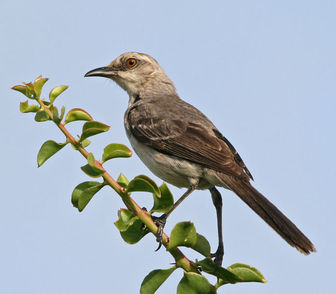Tropical Mockingbird
Adults are 25 cm long and weigh 54g. They are grey on the head and upper parts with yellow eyes, a white eye stripe and dark patch through the eye. The underparts are off-white and the wings are blackish with two white wing bars and white edges to the flight feathers. They have a long dark tail with white feather tips, a slim black bill with a slight downward curve, and long dark legs.

Original source: http://www.birdphotos.com/photos/v/song/mimidae/IMG_1422b.jpg.html
Author: http://www.birdphotos.com
The Tropical Mockingbird is classified as Least Concern. Does not qualify for a more at risk category. Widespread and abundant taxa are included in this category.
The Tropical Mockingbird, Mimus gilvus, is a resident breeding bird from southern Mexico south to northern Brazil, and in the Lesser Antilles and other Caribbean islands. The birds in Panama and Trinidad may have been introduced. The Northern Mockingbird (M. polyglottos) is its closest living relative, but the critically endangered Socorro Mockingbird (M. graysoni) is also much closer to these two than previously believed . Adults are 25 cm long and weigh 54g. More
Tropical Mockingbirds forage on the ground or in vegetation or fly down from a perch to capture invertebrates. They mainly eat insects and some berries. These fearless birds will also take food off unattended plates or tables. While foraging they will frequently spread their wings in a peculiar two-step motion, flashing the white wing linings, and then fold them again. More
Tropical Mockingbirds can be lured to your patio for great looks (unlike the look provided by this photo) with fresh fruit. Photo Jeff Wells The photo to your left shows some of the Tropical Mockingbird field marks. Photo Matt Victoria. The chuchubi, as it is called in the local papiemento language, is one of the most loved and most obvious species you’ll encounter on the island. More
Aspects of the topic tropical mockingbird are discussed in the following places at Britannica. Assorted References * habitation (in mockingbird (bird)) ...long and gray with darker wings and tail both marked with white. It ranges from the northern United States to Mexico—or to Brazil, if the tropical mockingbird (M. More
The Tropical Mockingbird is grey above with dark eye-steaks and whitish below, with a long white-tipped tail. It builds a rough nest of twigs in a bush or tree and is aggressively territorial while rearing it More
Tropical Mockingbird, Mimus polyglottos, photographed in the Yucatan Though his calling seems identical to what I grew up hearing in Kentucky, here the mockingbird species we have is the Tropical Mockingbird, MIMUS GILVUS, not the Northern Mockingbird, Mimus polyglottos, which is North America's mocker. The Northern Mockingbird reaches as far south as Mexico's Isthmus of Tehuantepec, but then on this side of the Isthmus Tropical Mockingbirds take over. More
Tropical MockingbirdBirds in Suriname = - Tropical Mockingbird in Suriname Moqueur des savanes, Sabi More
The Tropical Mockingbird's song is very similar to that of the migratory Northern Mockingbird (Mimus polyglottos), consisting of a long rolling series of buzzy and clear whistled syllables. Howell and Webb (1995) suggest that the tropical and migratory species cannot be distinguished by song alone. More

Original source: Brian Gratwicke
Author: Brian Gratwicke
Permission: Some rights reserved

